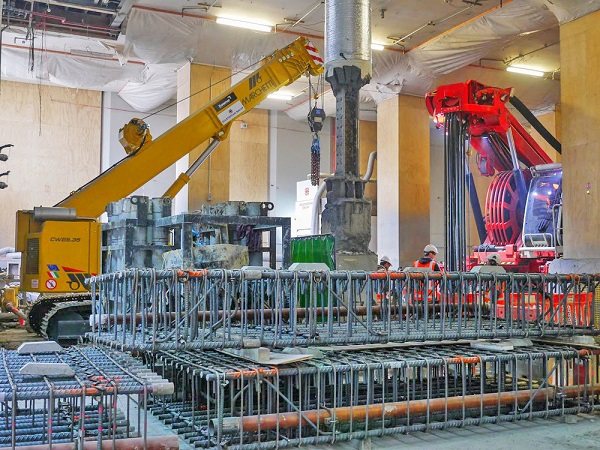ISCA New Zealand Summit Preview: Q&A With Downer Soletanche Bachy JV

Downer Soletanche Bachy (JV) are sponsoring the ‘Regional investment in sustainable infrastructure’ panel session at the 2018 ISCA New Zealand Summit. We caught up DSBJV to find out why this sponsorship was important for them, and to understand more about their sustainability drive in New Zealand.
- Why did you decide to partner with ISCA for the Infrastructure Sustainability Summit?
This is the first project DSBJV have undertaken with ISCA in NZ. Life to date on the project we have achieved some significant sustainable outcomes as a result of the focus that ISCA has brought to the project team. As one of the first projects working with the Infrastructure Sustainability rating scheme in New Zealand, we considered it important to step up and support ISCA with the inaugural IS summit in NZ, to engage with fellow peers in the infrastructure industry and share our knowledge and experience with the group.
- Can you explain the project the joint venture between Downer and Soletanche Bachy is delivering?
This is the first section of the City Rail Link project in Auckland. It is one of the most technically challenging engineering parts of the project. It involves constructing the rail tunnels from the existing Britomart station under the former Chief Post Office (CPO) building to the west side of Lower Queen Street some 13m below current road levels.
- What are some of the other ways Downer Soletanche Bachy is demonstrating sustainability leadership?
We have been part of the successful team that has achieved the “Lead” rating for the design phase of this project. As the IS rating scheme is reasonably new to New Zealand we are taking our project partners through the journey to a more sustainable project delivery system assisting in learning as we go. Recognising that smarter supply chains are an important part to achieving success, DSBJV held the first NZ suppliers and subcontractors sustainability workshop in December 2017. The event was attended by 45 key existing and prospective suppliers and subcontractors. The purpose of the event was to engage with suppliers to explain the sustainability requirements and expectations of the project, and their importance in the bid process in more detail and to provide some tangible examples of sustainability initiatives and innovations realized on the project to date in an attempt to stimulate innovation amongst the supply chain. This event was a great success, and we intend to follow up with further engagement events in the future.
- Downer has done some impressive firsts in sustainable infrastructure, first renewable energy asset, first roads in Tasmania, first toner roads– can you explain the highlights here and why Downer Soletanche Bachy continues to be first?
Some highlights or firsts on this project have included:
- Working with local manufacturer Pacific Steel in Otahuhu, which uses NZ manufactured steel from a steel mill in Auckland, to fabricate NZs first 50 mm reinforcing bar. Besides improving constructability, using this larger diameter steel reduced the total weight of steel required by 82 tonnes, lowering associated greenhouse gas emissions by just over 100 tCO2e. It also reduces transport emissions and costs associated with sourcing it offshore.
- We identified an innovative use for lightweight polystyrene blocks, which were used to create a piling platform inside the CPO Building. This resulted in less new materials required (replacing crushed concrete backfill with polystyrene, and reducing the number of mini piles required to support the platform by more than half), less diesel use (for drilling piles, and delivering/compacting the backfill), as well as being faster and reducing the value of the works significantly. In addition, DSBJV negotiated a buy back agreement with the polystyrene supplier. When the piling platform is demolished, the polystyrene will be returned to the supplier for reuse as underfloor insulation avoiding waste to landfill.
- We are leading the way in NZ with an innovative monitoring system for noise and vibration which provides real time, 24/7 monitoring and alerts. This system allows us to identify any unexpected exceedances, to evaluate mitigation/management options, and enables informed engagement with the community. Overall this system is resulting in better outcomes around noise and vibration for our neighbours.
- We are also working with Z Energy to procure the first biodiesel (B20) from their plant to supply fuel to the project for bulk excavation works.
- What are you particularly proud of and why?
We have achieved great success with waste diversion, demonstrating our commitment to CRLLs vision of zero waste to landfill. To date the project has diverted 99 % of construction and demolition waste from landfill and much improved diversion of office waste.
We have also established a good system of reporting with our suppliers and subcontractors which allows us to collate materials, energy and water use data monthly, which is well above business as usual for the construction industry in NZ. To date, project energy and water use are tracking below both the base case, and the detailed design projections.
- How has using the ISCA framework helped to drive more sustainable outcomes for your projects?
By providing a framework from which to target our goals, measure our progress and celebrate our successes, also to focus on areas of improvement all while building our awareness and how to achieve a more sustainable project.
- What’s next for Downer Soletanche Bachy?
Achieve a “Leading” IS As Built rating for the project then look to expand these processes to our wider company and other NZ projects.

